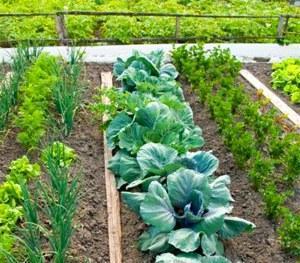Plant compatibility in the garden will help increase yields
 Some plants get along well with each other, others are at enmity. If you plant nearby plants that do not like each other, then the yield will significantly decrease. When planting compatible plants in the garden, you can get an increased yield, achieve accelerated growth and luxurious flowering, and protect vegetables from pests and diseases.
Some plants get along well with each other, others are at enmity. If you plant nearby plants that do not like each other, then the yield will significantly decrease. When planting compatible plants in the garden, you can get an increased yield, achieve accelerated growth and luxurious flowering, and protect vegetables from pests and diseases.
What are the benefits of plant compatibility in the garden?
Thanks to the compatibility of plants in the garden, you will be able to:
- rational use of the area of the site;
- joint placement of vegetables of various ripening periods;
- eat fresh vegetables from your garden throughout the season;
- application of the beneficial effect of different plants on each other.
How to determine the compatibility of plants in the garden?
Basil will help prevent caryopsis from infesting legumes. Also, their proximity to cucumbers, radishes, sweet corn, potatoes, mustard and spinach has a beneficial effect on the yield of legumes. But legumes do not get along with onions and garlic.
Peas feel great next to carrots, turnips, cucumbers, radishes, lettuce and parsley. It grows poorly next to wormwood.
Bush beans planted next to eggplants will protect them from Colorado beetles, and thyme will speed up their growth.
Earthen fleas will not touch cabbage if celery grows near it. Dill will save cabbage from caterpillars. Moreover, it will improve her taste. If you plant a medicinal borage next to a cabbage, then snails will not touch it. Cabbage butterflies will fly around the side of the cabbage bed if lettuce grows on it. Rosemary, sage and mint will help scare away insects from cabbage.
The ideal neighbor for potatoes is beans. She will scare off the Colorado beetles and saturate the soil with nitrogen. If the area with potatoes is surrounded by nasturtium, marigolds, coriander or tansy, then the Colorado potato beetle will stay away from it. They go well with potatoes radishes, cauliflower, corn and lettuce. Doesn't like potatoes next to sunflowers, celery, tomatoes and eggplants.
The harvest of cucumbers will increase if you plant celery, beans, beets, lettuce, corn and beans near them.
Corn is friendly to most vegetable crops. The exceptions are beets and celery.
Tomatoes are moody and poorly compatible plants in the garden. They do not like potatoes, dill, fennel and kohlrabi... They are neutral in relation to corn, radish, garlic, beets and carrots. They treat only lemon balm and basil favorably: from the neighborhood with these plants, tomatoes improve their taste.
If you take into account the compatibility of plants in the garden when planting, then the garden will always delight you, and the neighbors will envy your harvest.

In conditions of insufficient land, you want to compact the plants.But thickened plantings will lead to the occurrence of diseases, a lack of space for food. Usually, in order for the carrots to be spacious when pouring, I sow a row of carrots, a row of radishes. You can sow them early, and then remove the radishes, and at this time the carrots can already be thinned out, and let it be poured large and even. Everyone loves peas. Tall, more productive. In order not to put sticks, not to fence the nets, I plant sunflower seedlings near it. The grown stem overtakes peas in growth. They ate the peas, and the sunflower is poured further, and even received top dressing at the expense of peas. It's good to plant garlic on strawberries. Usually I don't grow it on heads in strawberries, we use young greens. But phytoncides kill the infection, and the first berry is clean, without fruits spoiled by gray rot.
Plants are compatible that do not have common diseases and pests that do not interfere with each other's development. Those who need the same conditions for development. Cucumbers and tomatoes are not combined, because tomatoes need intensive ventilation, and cucumbers like high humidity without drafts.